Analyzing Temporal Characteristics of Winter Catch Crops Using Sentinel-1 Time Series
Abstract
:1. Introduction
2. Materials and Methods
2.1. Study Area and Ground-Truth Campaigns
2.2. Satellite Data
2.3. SAR Data Preprocessing
2.4. Temporal Profile Analysis
2.5. Descriptive Features Extraction
2.6. Kruskal–Wallis H-Test
2.7. Dunn’s Post Hoc Test
3. Results
3.1. S-1 VV, VH-Backscatter
3.2. S-1 VH/VV Backscatter
3.3. Dual-Pol Radar Vegetation Index
3.4. S-1 VV-Coherence Analysis
3.5. Comparison of Temporal Patterns of Winter Main Crops and Fallow with Catch Crop
3.6. Descriptive Features Extraction
3.7. Kruskal–Wallis H-Test and Its Significance
3.8. Dunn’s Post Hoc Test and Pairwise Significance
4. Discussion
5. Conclusions
Author Contributions
Funding
Data Availability Statement
Acknowledgments
Conflicts of Interest
Appendix A. Kruskal-Wallis Crop-Wise Test Results
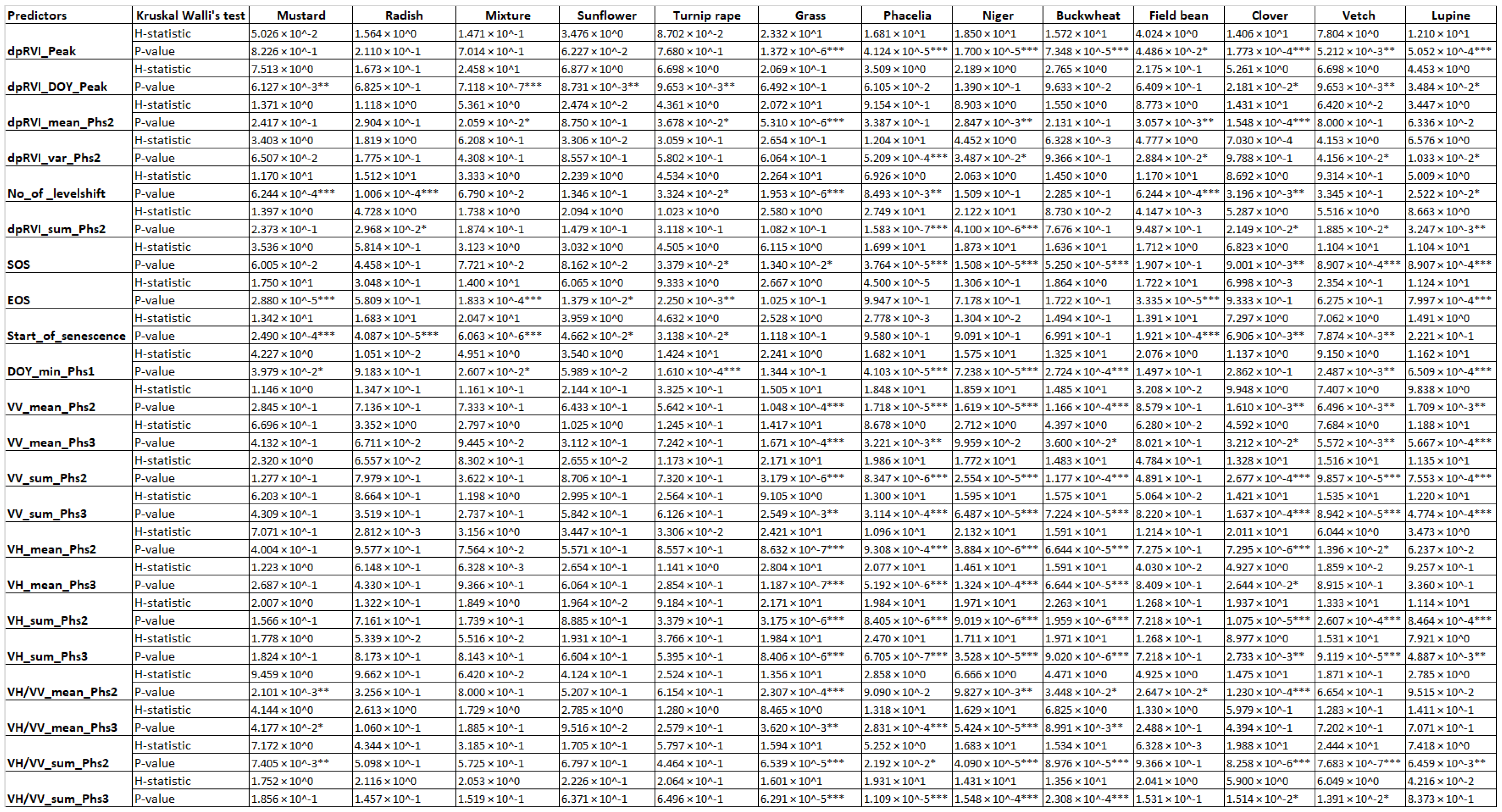
References
- European Commission. Communication from the Commission to the European Parliament, the Council, the European Economic and Social Committee and the Committee of the Regions. Stepping up Europe’s 2030 Climate Ambition. Investing in a Climate-Neutral Future for the Benefit of Our People. Brussels, Belgium. 2020. Available online: https://eur-lex.europa.eu/legal-content/EN/TXT/PDF/?uri=CELEX:52020DC0562&from=en (accessed on 10 June 2024).
- Yıldız, T. Green Horizons: Reflections of the European Union’s Environmental Policy in Action. Int. J. Soc. Humanit. Sci. Res. (JSHSR) 2024, 11, 729–739. [Google Scholar]
- Blandford, D.; Hassapoyannes, K. The common agricultural policy in 2020: Responding to climate change. In Research Handbook on EU Agriculture Law; Edward Elgar Publishing: Northampton, MA, USA, 2015; pp. 170–202. [Google Scholar]
- De Castro, P.; Miglietta, P.P.; Vecchio, Y. The Common Agricultural Policy 2021–2027: A new history for European agriculture. Riv. Econ. Agrar. 2020, 75, 5–12. [Google Scholar]
- Blanco, H. Cover Crops and Soil Ecosystem Services; John Wiley & Sons, Inc.: Hoboken, NJ, USA, 2023; pp. 1–242. [Google Scholar] [CrossRef]
- Schipanski, M.E.; Barbercheck, M.; Douglas, M.R.; Finney, D.M.; Haider, K.; Kaye, J.P.; Kemanian, A.R.; Mortensen, D.A.; Ryan, M.R.; Tooker, J.; et al. A framework for evaluating ecosystem services provided by cover crops in agroecosystems. Agric. Syst. 2014, 125, 12–22. [Google Scholar] [CrossRef]
- Udupa, S.M. Project Final Report: Optimising Subsidiary Crop Applications in Rotations (OSCAR); European Union: Brussels, Belgium, 2016. [Google Scholar]
- Seitz, D.; Fischer, L.M.; Dechow, R.; Wiesmeier, M.; Don, A. The potential of cover crops to increase soil organic carbon storage in German croplands. Plant Soil 2023, 488, 157–173. [Google Scholar] [CrossRef]
- Delgado, J.A.; Dillon, M.A.; Sparks, R.T.; Essah, S.Y. A decade of advances in cover crops. J. Soil Water Conserv. 2007, 62, 110A–117A. [Google Scholar]
- KC, K.; Zhao, K.; Romanko, M.; Khanal, S. Assessment of the spatial and temporal patterns of cover crops using remote sensing. Remote Sens. 2021, 13, 2689. [Google Scholar] [CrossRef]
- Saad El Imanni, H.; El Harti, A.; Panimboza, J. Investigating Sentinel-1 and Sentinel-2 Data Efficiency in Studying the Temporal Behavior of Wheat Phenological Stages Using Google Earth Engine. Agriculture 2022, 12, 1605. [Google Scholar] [CrossRef]
- Brisco, B.; Brown, R.; Hirose, T.; McNairn, H.; Staenz, K. Precision agriculture and the role of remote sensing: A review. Can. J. Remote Sens. 1998, 24, 315–327. [Google Scholar] [CrossRef]
- Bargiel, D. A new method for crop classification combining time series of radar images and crop phenology information. Remote Sens. Environ. 2017, 198, 369–383. [Google Scholar] [CrossRef]
- Asam, S.; Gessner, U.; Almengor González, R.; Wenzl, M.; Kriese, J.; Kuenzer, C. Mapping crop types of Germany by combining temporal statistical metrics of Sentinel-1 and Sentinel-2 time series with LPIS data. Remote Sens. 2022, 14, 2981. [Google Scholar] [CrossRef]
- Steinhausen, M.J.; Wagner, P.D.; Narasimhan, B.; Waske, B. Combining Sentinel-1 and Sentinel-2 data for improved land use and land cover mapping of monsoon regions. Int. J. Appl. Earth Obs. Geoinf. 2018, 73, 595–604. [Google Scholar] [CrossRef]
- Blickensdörfer, L.; Schwieder, M.; Pflugmacher, D.; Nendel, C.; Erasmi, S.; Hostert, P. Mapping of crop types and crop sequences with combined time series of Sentinel-1, Sentinel-2 and Landsat 8 data for Germany. Remote Sens. Environ. 2022, 269, 112831. [Google Scholar] [CrossRef]
- Zhou, X.; Wang, J.; He, Y.; Shan, B. Crop classification and representative crop rotation identifying using statistical features of time-series sentinel-1 GRD data. Remote Sens. 2022, 14, 5116. [Google Scholar] [CrossRef]
- Ren, T.; Xu, H.; Cai, X.; Yu, S.; Qi, J. Smallholder crop type mapping and rotation monitoring in mountainous areas with Sentinel-1/2 imagery. Remote Sens. 2022, 14, 566. [Google Scholar] [CrossRef]
- Schulz, C.; Holtgrave, A.K.; Kleinschmit, B. Large-scale winter catch crop monitoring with sentinel-2 time series and machine learning–an alternative to on-site controls? Comput. Electron. Agric. 2021, 186, 106173. [Google Scholar] [CrossRef]
- Ahmed, Z.; Nalley, L.; Brye, K.; Green, V.S.; Popp, M.; Shew, A.M.; Connor, L. Winter-time cover crop identification: A remote sensing-based methodological framework for new and rapid data generation. Int. J. Appl. Earth Obs. Geoinf. 2023, 125, 103564. [Google Scholar] [CrossRef]
- Barnes, M.L.; Yoder, L.; Khodaee, M. Detecting winter cover crops and crop residues in the midwest US using machine learning classification of thermal and optical imagery. Remote Sens. 2021, 13, 1998. [Google Scholar] [CrossRef]
- Swoish, M.; Leme Filho, J.F.D.C.; Reiter, M.S.; Campbell, J.B.; Thomason, W.E. Comparing satellites and vegetation indices for cover crop biomass estimation. Comput. Electron. Agric. 2022, 196, 106900. [Google Scholar] [CrossRef]
- Prabhakara, K.; Hively, W.D.; McCarty, G.W. Evaluating the relationship between biomass, percent groundcover and remote sensing indices across six winter cover crop fields in Maryland, United States. Int. J. Appl. Earth Obs. Geoinf. 2015, 39, 88–102. [Google Scholar] [CrossRef]
- Roth, L.; Streit, B. Predicting cover crop biomass by lightweight UAS-based RGB and NIR photography: An applied photogrammetric approach. Precis. Agric. 2018, 19, 93–114. [Google Scholar] [CrossRef]
- Assmann, J.J.; Kerby, J.T.; Cunliffe, A.M.; Myers-Smith, I.H. Vegetation monitoring using multispectral sensors—Best practices and lessons learned from high latitudes. J. Unmanned Veh. Syst. 2018, 7, 54–75. [Google Scholar] [CrossRef]
- McNairn, H.; Shang, J.; Jiao, X.; Champagne, C. The contribution of ALOS PALSAR multipolarization and polarimetric data to crop classification. IEEE Trans. Geosci. Remote Sens. 2009, 47, 3981–3992. [Google Scholar] [CrossRef]
- Fieuzal, R.; Baup, F.; Marais-Sicre, C. Sensitivity of TerraSAR-X, RADARSAT-2 and ALOS satellite radar data to crop variables. In Proceedings of the 2012 IEEE International Geoscience and Remote Sensing Symposium, Munich, Germany, 22–27 July 2012; pp. 3740–3743. [Google Scholar] [CrossRef]
- Lopez-Sanchez, J.M.; Cloude, S.R.; Ballester-Berman, J.D. Rice Phenology Monitoring by Means of SAR Polarimetry at X-Band. IEEE Trans. Geosci. Remote Sens. 2012, 50, 2695–2709. [Google Scholar] [CrossRef]
- Shao, Y.; Fan, X.; Liu, H.; Xiao, J.; Ross, S.; Brisco, B.; Brown, R.; Staples, G. Rice monitoring and production estimation using multitemporal RADARSAT. Remote Sens. Environ. 2001, 76, 310–325. [Google Scholar] [CrossRef]
- Harfenmeister, K.; Spengler, D.; Weltzien, C. Analyzing temporal and spatial characteristics of crop parameters using Sentinel-1 backscatter data. Remote Sens. 2019, 11, 1569. [Google Scholar] [CrossRef]
- Tan, C.P.; Ewe, H.T.; Chuah, H.T. Agricultural crop-type classification of multi-polarization SAR images using a hybrid entropy decomposition and support vector machine technique. Int. J. Remote Sens. 2011, 32, 7057–7071. [Google Scholar] [CrossRef]
- Wang, D.; Lin, H.; Chen, J.; Zhang, Y.; Zeng, Q. Application of multi-temporal ENVISAT ASAR data to agricultural area mapping in the Pearl River Delta. Int. J. Remote Sens. 2010, 31, 1555–1572. [Google Scholar] [CrossRef]
- Shanmugapriya, S.; Haldar, D.; Danodia, A. Optimal datasets suitability for pearl millet (Bajra) discrimination using multiparametric SAR data. Geocarto Int. 2020, 35, 1814–1831. [Google Scholar] [CrossRef]
- Arias, M.; Campo-Bescós, M.Á.; Álvarez-Mozos, J. Crop classification based on temporal signatures of Sentinel-1 observations over Navarre province, Spain. Remote Sens. 2020, 12, 278. [Google Scholar] [CrossRef]
- Choudhury, I.; Chakraborty, M. SAR signature investigation of rice crop using RADARSAT data. Int. J. Remote Sens. 2006, 27, 519–534. [Google Scholar] [CrossRef]
- Sah, S.; Haldar, D.; Chandra, S.; Nain, A.S. Discrimination and monitoring of rice cultural types using dense time series of Sentinel-1 SAR data. Ecol. Inform. 2023, 76, 102136. [Google Scholar] [CrossRef]
- Betbeder, J.; Fieuzal, R.; Philippets, Y.; Ferro-Famil, L.; Baup, F. Contribution of multitemporal polarimetric synthetic aperture radar data for monitoring winter wheat and rapeseed crops. J. Appl. Remote Sens. 2016, 10, 026020. [Google Scholar] [CrossRef]
- Regional State of Play Analyses; Braunschweig, Germany. 2021. Available online: https://suwanu-europe.eu/wp-content/uploads/2021/05/State-of-play_Braunschweig-Germany.pdf (accessed on 12 July 2024).
- Regionalstatistik. Flächennutzung. Available online: https://www.regionalstatistik.de/genesis/online (accessed on 12 July 2024).
- Lüker-Jans, N.; Simmering, D.; Otte, A. Analysing data of the integrated administration and control system (IACS) to detect patterns of agricultural land-use change at municipality level. Landsc. Online 2016, 48. [Google Scholar] [CrossRef]
- Stein, S.; Steinmann, H.H. Identifying crop rotation practice by the typification of crop sequence patterns for arable farming systems—A case study from Central Europe. Eur. J. Agron. 2018, 92, 30–40. [Google Scholar] [CrossRef]
- Benz, U.; Banovsky, I.; Cesarz, A.; Schmidt, M. CODE-DE Portal Handbook; Version 2.0. 2020. Available online: https://code-de.cdn.prismic.io/code-de/ff151913-16e0-4dc3-8005-696bf25bf65d_User+Manual_v2.0.2_ENG.pdf (accessed on 15 March 2023).
- Srivastava, H.S.; Patel, P.; Prasad, S.; Sharma, Y.; Khan, B.A.; Praveen, B.; Sharma, S.; Vijayan, L.; Vijayan, V. Potential applications of multi-parametric synthetic aperture radar (SAR) data in wetland inventory: A case study of Keoladeo National Park (A World Heritage and Ramsar site), Bharatpur, India. In Proceedings of the 12th World Lake Conference, TAAL, Jaipur, India, 28 October–2 November 2007. [Google Scholar]
- Wood, D.; McNairn, H.; Brown, R.; Dixon, R. The effect of dew on the use of RADARSAT-1 for crop monitoring: Choosing Between Ascending and Descending Orbits. Remote Sens. Environ. 2002, 80, 241–247. [Google Scholar] [CrossRef]
- Khabbazan, S.; Vermunt, P.; Steele-Dunne, S.; Ratering Arntz, L.; Marinetti, C.; van der Valk, D.; Iannini, L.; Molijn, R.; Westerdijk, K.; van der Sande, C. Crop monitoring using Sentinel-1 data: A case study from The Netherlands. Remote Sens. 2019, 11, 1887. [Google Scholar] [CrossRef]
- Bouvet, A.; Le Toan, T.; Lam-Dao, N. Monitoring of the rice cropping system in the Mekong Delta using ENVISAT/ASAR dual polarization data. IEEE Trans. Geosci. Remote Sens. 2009, 47, 517–526. [Google Scholar] [CrossRef]
- McNairn, H.; Shang, J. A review of multitemporal synthetic aperture radar (SAR) for crop monitoring. In Multitemporal Remote Sensing: Methods and Applications; Springer: Cham, Switzerland, 2016; pp. 317–340. [Google Scholar]
- Chauhan, S.; Darvishzadeh, R.; Lu, Y.; Boschetti, M.; Nelson, A. Understanding wheat lodging using multi-temporal Sentinel-1 and Sentinel-2 data. Remote Sens. Environ. 2020, 243, 111804. [Google Scholar] [CrossRef]
- Blaes, X.; Vanhalle, L.; Defourny, P. Efficiency of crop identification based on optical and SAR image time series. Remote Sens. Environ. 2005, 96, 352–365. [Google Scholar] [CrossRef]
- DWD Climate Data Center (CDC). Available online: https://www.dwd.de/EN/climate_environment/cdc/ (accessed on 17 September 2024).
- Baumann, P. A general conceptual framework for multi-dimensional spatio-temporal data sets. Environ. Model. Softw. 2021, 143, 105096. [Google Scholar] [CrossRef]
- McClelland, J.; Riedel, T.; Beyer, F.; Gerighausen, H.; Golla, B. State of the Art Open Access Remote Sensing with ESA Sentinel 1 SAR Data; Gesellschaft für Informatik e.V.: Bonn, Germany, 2023. [Google Scholar]
- Truckenbrodt, J.; Cremer, F.; Baris, I.; Eberle, J. pyroSAR—A Framework for Large-Scale SAR Satellite Data Processing. In Proceedings of the Big Data from Space, Munich, Germany, 19–21 February 2019; pp. 19–20. [Google Scholar]
- Guo, Z.; Qi, W.; Huang, Y.; Zhao, J.; Yang, H.; Koo, V.C.; Li, N. Identification of crop type based on C-AENN using time series Sentinel-1A SAR data. Remote Sens. 2022, 14, 1379. [Google Scholar] [CrossRef]
- Mandal, D.; Kumar, V.; Ratha, D.; Dey, S.; Bhattacharya, A.; Lopez-Sanchez, J.M.; McNairn, H.; Rao, Y.S. Dual polarimetric radar vegetation index for crop growth monitoring using sentinel-1 SAR data. Remote Sens. Environ. 2020, 247, 111954. [Google Scholar] [CrossRef]
- Mandal, D.; Bhattacharya, A.; Rao, Y.S.; Mandal, D.; Bhattacharya, A.; Rao, Y.S. Radar vegetation indices for crop growth monitoring. In Radar Remote Sensing for Crop Biophysical Parameter Estimation; Springer: Singapore, 2021; pp. 177–228. [Google Scholar]
- Touzi, R.; Lopes, A.; Bruniquel, J.; Vachon, P.W. Coherence estimation for SAR imagery. IEEE Trans. Geosci. Remote Sens. 1999, 37, 135–149. [Google Scholar] [CrossRef]
- Amherdt, S.; Di Leo, N.C.; Pereira, A.; Cornero, C.; Pacino, M.C. Assessment of interferometric coherence contribution to corn and soybean mapping with Sentinel-1 data time series. Geocarto Int. 2022, 38, 1–22. [Google Scholar] [CrossRef]
- Veloso, A.; Mermoz, S.; Bouvet, A.; Le Toan, T.; Planells, M.; Dejoux, J.F.; Ceschia, E. Understanding the temporal behavior of crops using Sentinel-1 and Sentinel-2-like data for agricultural applications. Remote Sens. Environ. 2017, 199, 415–426. [Google Scholar] [CrossRef]
- Tamm, T.; Zalite, K.; Voormansik, K.; Talgre, L. Relating Sentinel-1 interferometric coherence to mowing events on grasslands. Remote Sens. 2016, 8, 802. [Google Scholar] [CrossRef]
- Meroni, M.; d’Andrimont, R.; Vrieling, A.; Fasbender, D.; Lemoine, G.; Rembold, F.; Seguini, L.; Verhegghen, A. Comparing land surface phenology of major European crops as derived from SAR and multispectral data of Sentinel-1 and-2. Remote Sens. Environ. 2021, 253, 112232. [Google Scholar] [CrossRef]
- Htitiou, A.; Möller, M.; Riedel, T.; Beyer, F.; Gerighausen, H. Towards Optimising the Derivation of Phenological Phases of Different Crop Types over Germany Using Satellite Image Time Series. Remote Sens. 2024, 16, 3183. [Google Scholar] [CrossRef]
- Haldar, D.; Verma, A.; Kumar, S.; Chauhan, P. Estimation of mustard and wheat phenology using multi-date Shannon entropy and Radar Vegetation Index from polarimetric Sentinel-1. Geocarto Int. 2022, 37, 5935–5962. [Google Scholar] [CrossRef]
- White, M.A.; Thornton, P.E.; Running, S.W. A continental phenology model for monitoring vegetation responses to interannual climatic variability. Glob. Biogeochem. Cycles 1997, 11, 217–234. [Google Scholar] [CrossRef]
- Kruskal, W.H.; Wallis, W.A. Use of ranks in one-criterion variance analysis. J. Am. Stat. Assoc. 1952, 47, 583–621. [Google Scholar] [CrossRef]
- Jett, D.; Speer, J. Comparison of parametric and nonparametric tests for differences in distribution. In Proceedings of the National Conference on Undergraduate Research (NCUR), Asheville, NC, USA, 7–9 April 2016; pp. 7–9. [Google Scholar]
- Pohlert, T. The pairwise multiple comparison of mean ranks package (PMCMR). R Package 2014, 27, 9. [Google Scholar]
- Xie, G.; Niculescu, S. Mapping crop types using sentinel-2 data machine learning and monitoring crop phenology with sentinel-1 backscatter time series in pays de Brest, Brittany, France. Remote Sens. 2022, 14, 4437. [Google Scholar] [CrossRef]
- Junod, M.F.; Reid, B.; Sims, I.; Miller, A.J. Cover crops in cereal rotations: A quantitative review. Soil Tillage Res. 2024, 238, 105997. [Google Scholar] [CrossRef]
- Nichols, G.A.; MacKenzie, C.A. Identifying research priorities through decision analysis: A case study for cover crops. Front. Sustain. Food Syst. 2023, 7, 1040927. [Google Scholar] [CrossRef]
- Domínguez Costa, A. Classification of Wheat and Barley Fields Using High-Resolution Sentinel-1 Backscatter Data. Bachelor’s Thesis, Universitat Politècnica de Catalunya, Barcelona, Spain, 2020. [Google Scholar]
- Nasirzadehdizaji, R.; Balik Sanli, F.; Abdikan, S.; Cakir, Z.; Sekertekin, A.; Ustuner, M. Sensitivity analysis of multi-temporal Sentinel-1 SAR parameters to crop height and canopy coverage. Appl. Sci. 2019, 9, 655. [Google Scholar] [CrossRef]
- Schuster, C.; Förster, M.; Kleinschmit, B. Testing the red edge channel for improving land-use classifications based on high-resolution multi-spectral satellite data. Int. J. Remote Sens. 2012, 33, 5583–5599. [Google Scholar] [CrossRef]
- Haldar, D.; Dave, V.; Misra, A.; Bhattacharya, B. Radar Vegetation Index for assessing cotton crop condition using RISAT-1 data. Geocarto Int. 2020, 35, 364–375. [Google Scholar] [CrossRef]
- Steele-Dunne, S.C.; McNairn, H.; Monsivais-Huertero, A.; Judge, J.; Liu, P.W.; Papathanassiou, K. Radar remote sensing of agricultural canopies: A review. IEEE J. Sel. Top. Appl. Earth Obs. Remote Sens. 2017, 10, 2249–2273. [Google Scholar] [CrossRef]
- Villarroya-Carpio, A.; Lopez-Sanchez, J.M.; Engdahl, M.E. Sentinel-1 interferometric coherence as a vegetation index for agriculture. Remote Sens. Environ. 2022, 280, 113208. [Google Scholar] [CrossRef]
- Nasirzadehdizaji, R.; Cakir, Z.; Sanli, F.B.; Abdikan, S.; Pepe, A.; Calo, F. Sentinel-1 interferometric coherence and backscattering analysis for crop monitoring. Comput. Electron. Agric. 2021, 185, 106118. [Google Scholar] [CrossRef]
- Barrett, B.; Whelan, P.; Dwyer, E. The use of C-and L-band repeat-pass interferometric SAR coherence for soil moisture change detection in vegetated areas. Open Remote Sens. J. 2012, 5, 37–53. [Google Scholar] [CrossRef]
- Haldar, D.; Chakraborty, M.; Manjunath, K.; Parihar, J. Role of polarimetric SAR data for discrimination/biophysical parameters of crops based on canopy architecture. Int. Arch. Photogramm. Remote Sens. Spat. Inf. Sci. 2014, 40, 737–744. [Google Scholar] [CrossRef]
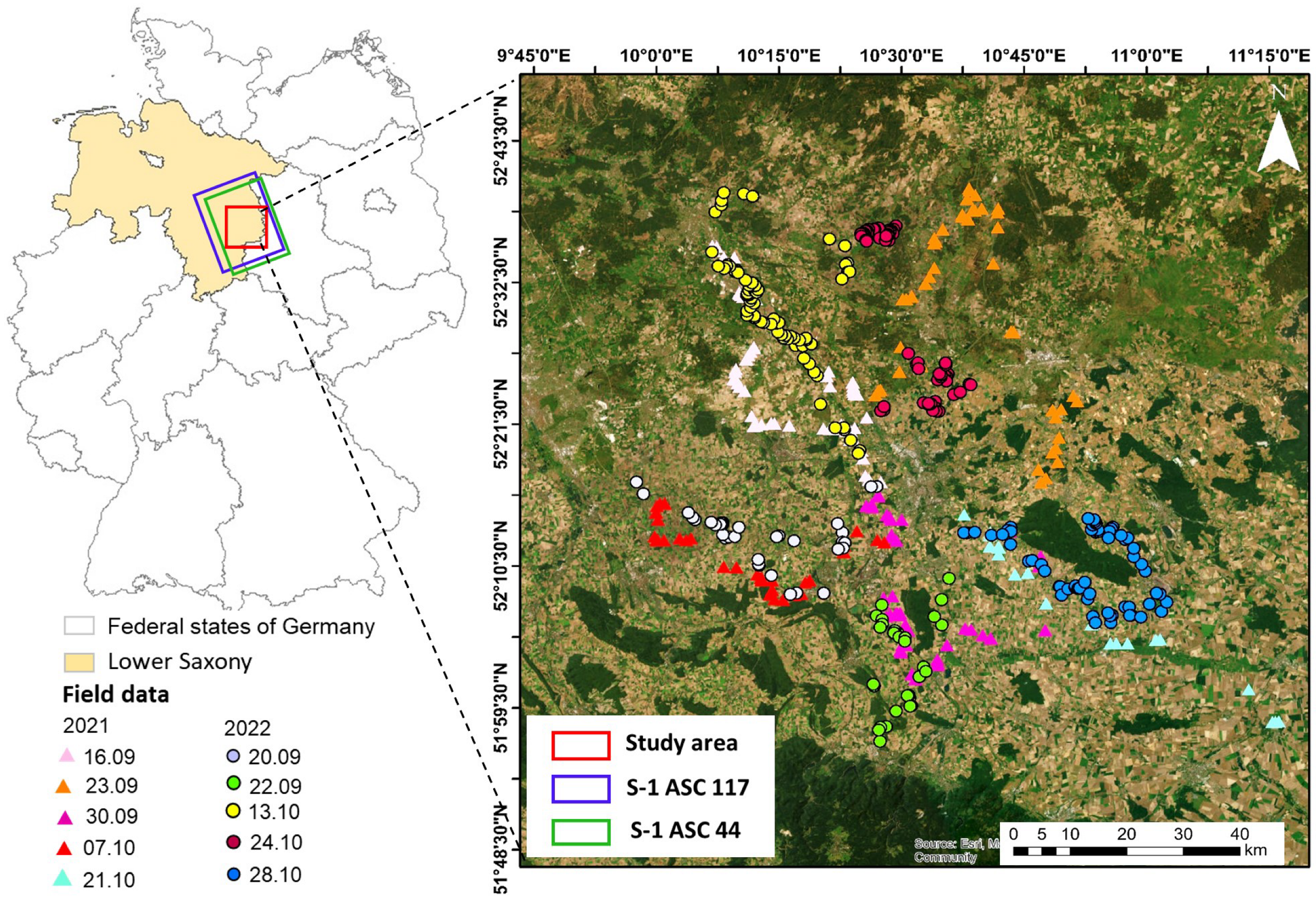
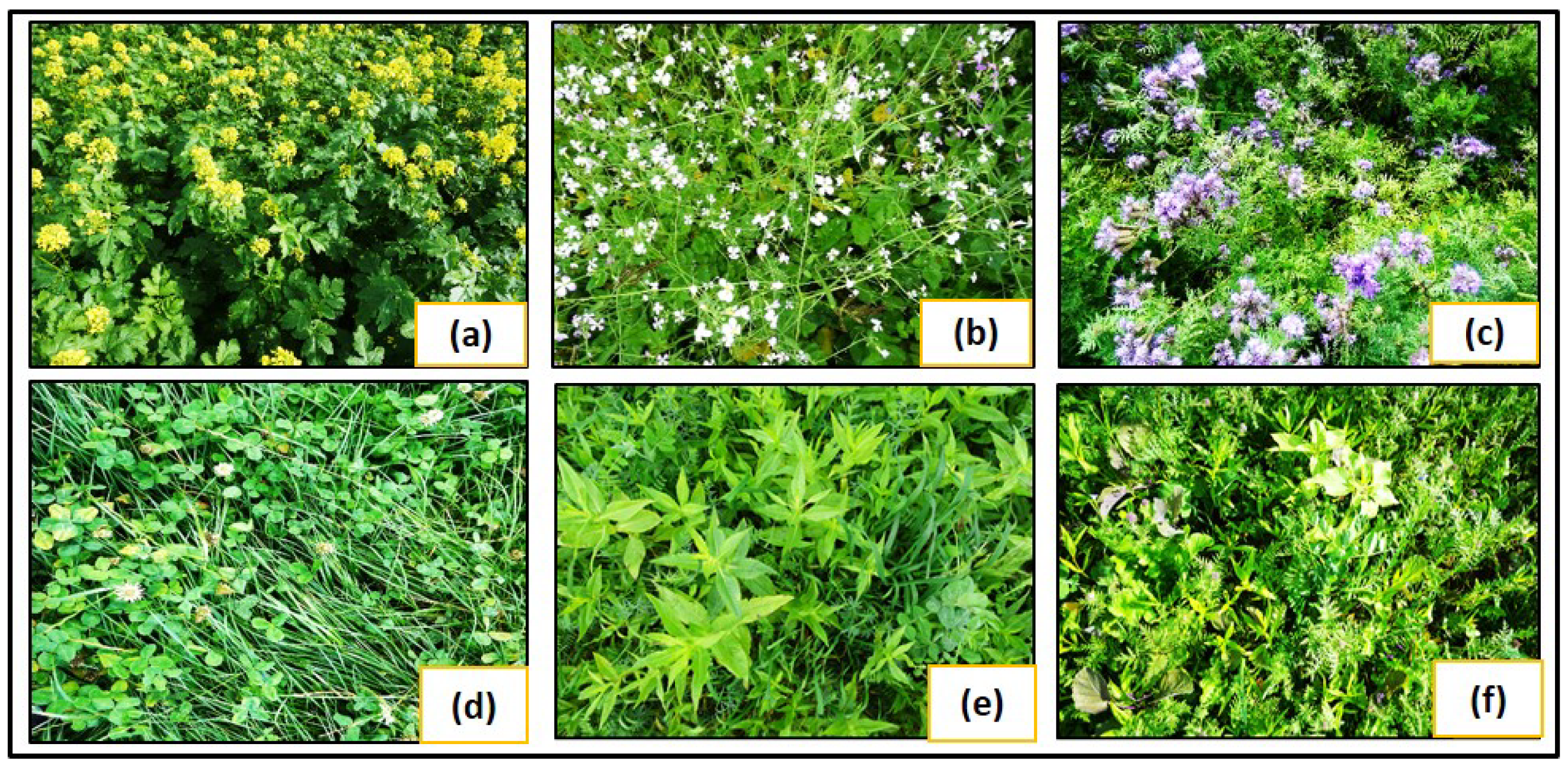
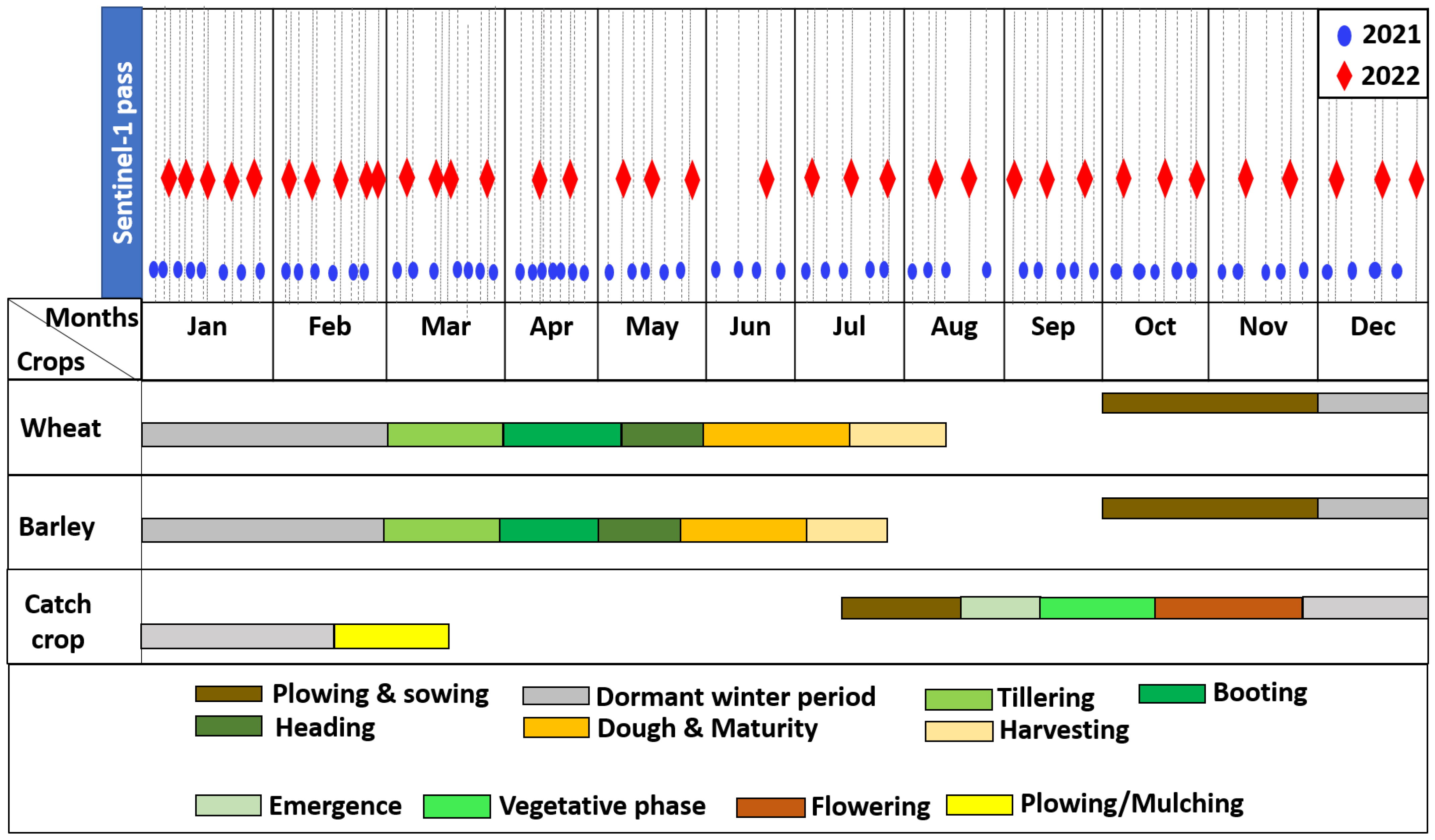


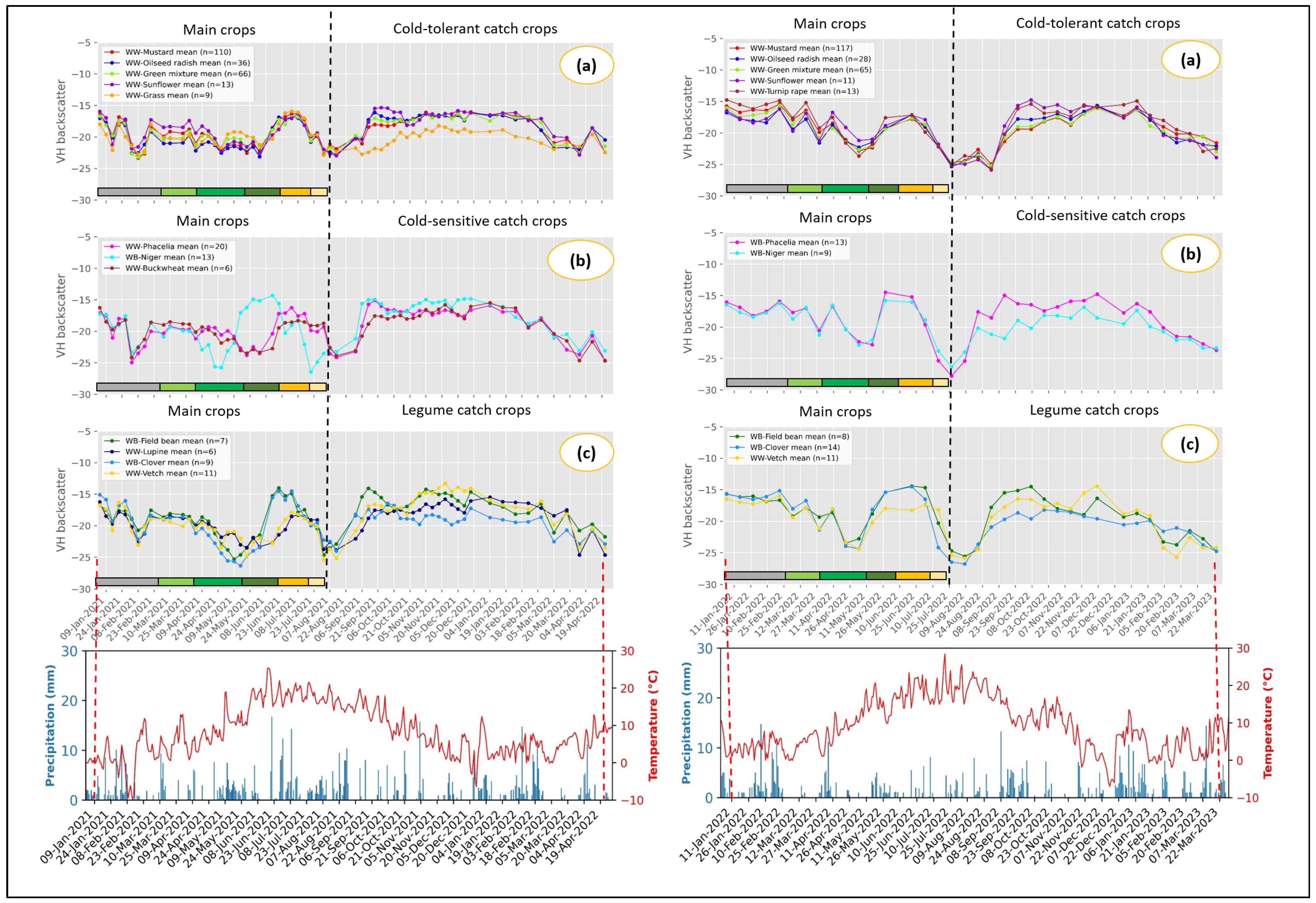

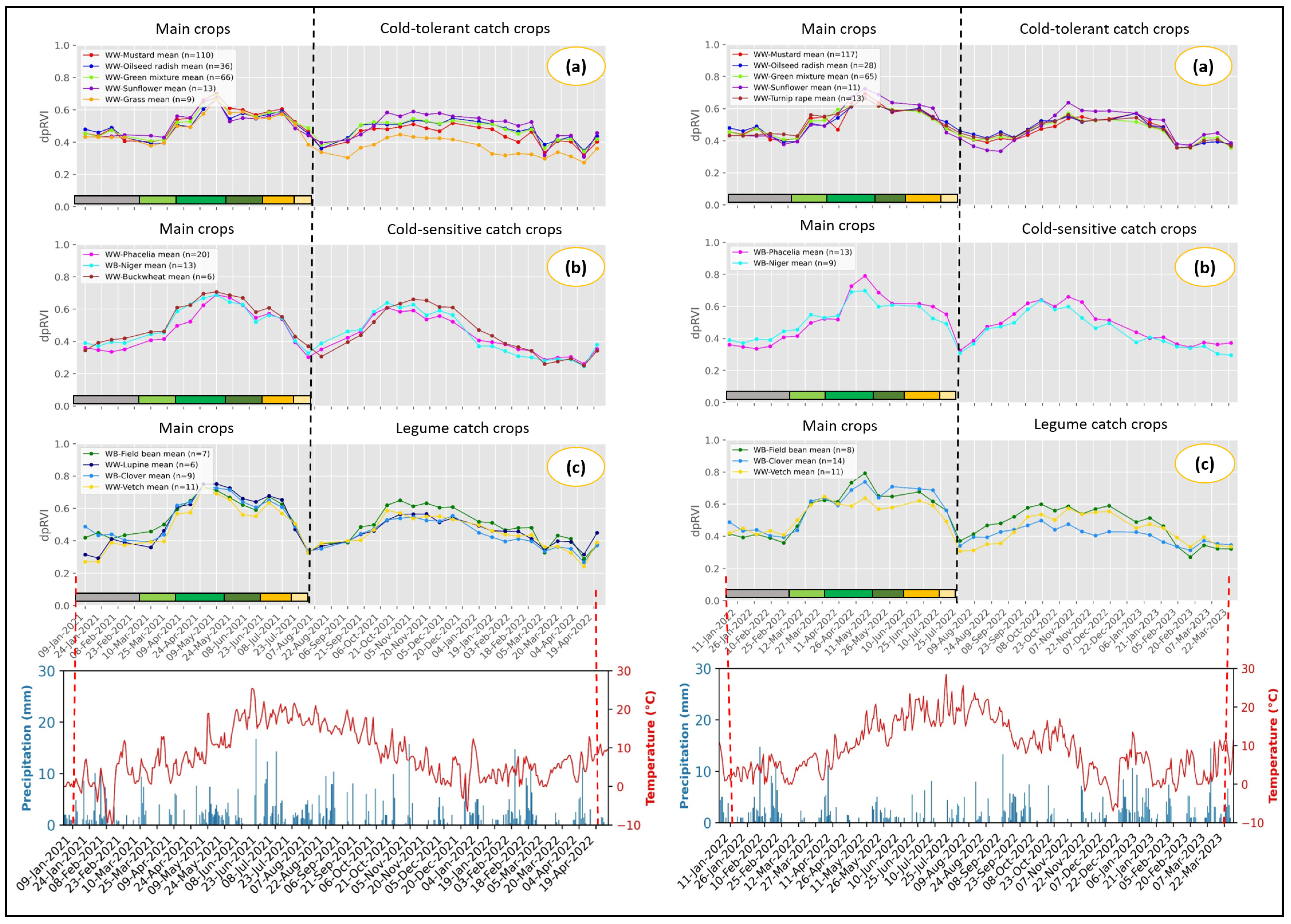
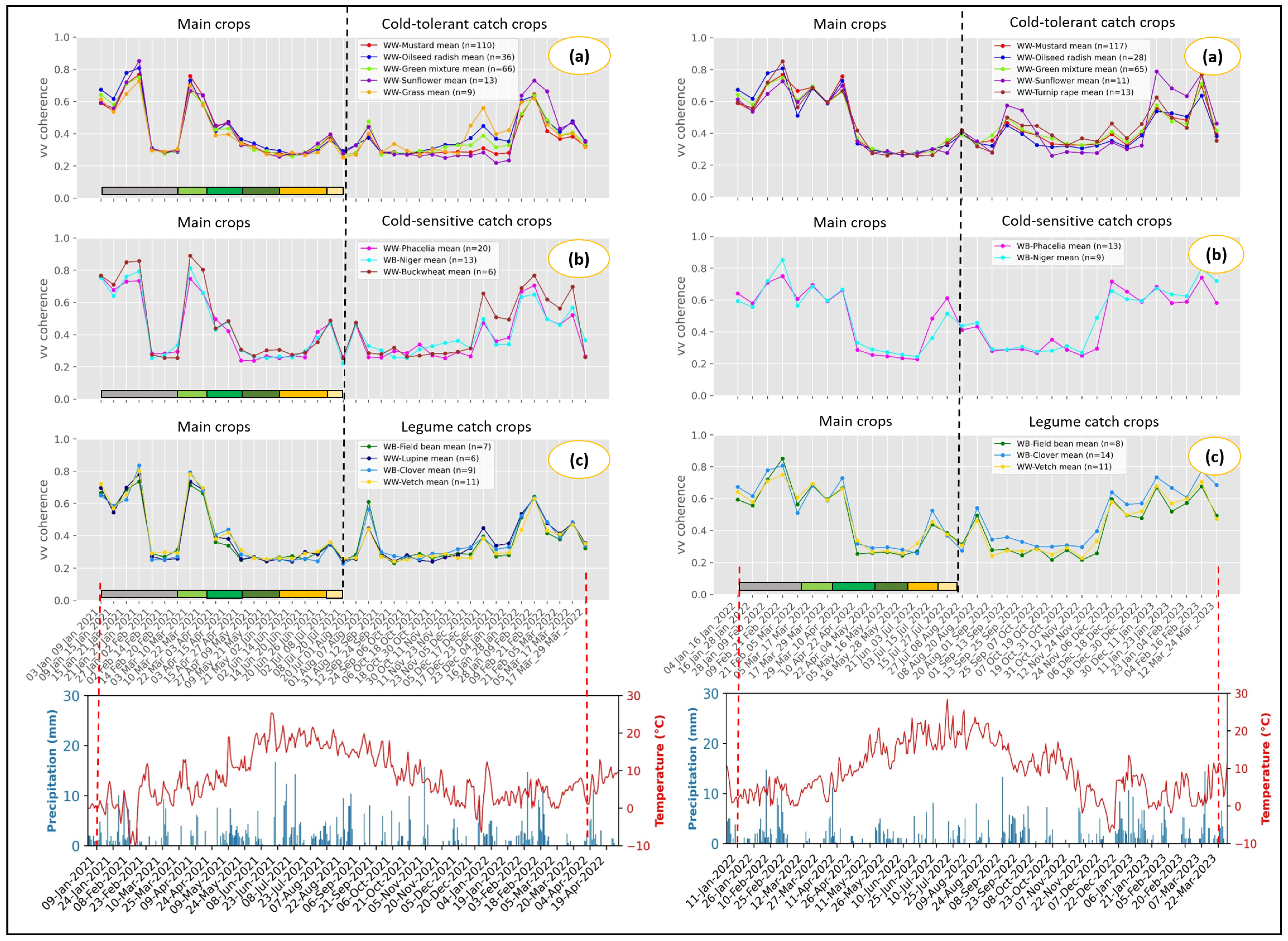






| No. | Categories | Catch Crops | No. of Samples | |
|---|---|---|---|---|
| 2021 | 2022 | |||
| 1 | Cold tolerant | Mustard | 110 | 117 |
| Oilseed radish | 36 | 28 | ||
| Green mixture | 66 | 65 | ||
| Sunflower | 13 | 11 | ||
| Grass | 9 | - | ||
| Turnip rape | - | 13 | ||
| 2 | Cold sensitive | Phacelia | 20 | 13 |
| Niger | 13 | 9 | ||
| Buckwheat | 6 | - | ||
| 3 | Legumes | Field bean | 7 | 8 |
| Lupine | 6 | - | ||
| Clover | 9 | 14 | ||
| Vetch | 11 | 11 | ||
| Sensor Parameters | Specifications |
|---|---|
| Wavelength | C-band |
| Frequency | 5.405 GHz |
| Product type | GRD, SLC |
| Incidence angle | 37.4°–45.1° |
| Acquisition mode | IW |
| Satellite pass | Ascending (ASC) |
| Polarization mode | VV, VH |
| Spatial resolution | 10 × 10 m |
| Temporal resolution | 6 days for 2021, |
| 12 days for 2022 |
| Descriptive Feature | Description | Example of Mustard Catch Crop Parcel |
|---|---|---|
| dpRVI_DOY_Peak | The day when the peak DpRVI value is reached and is computed by considering both Phase 2 and Phase 3. For cold-sensitive varieties and early-sown varieties, the DOY peak is expected to be early. | 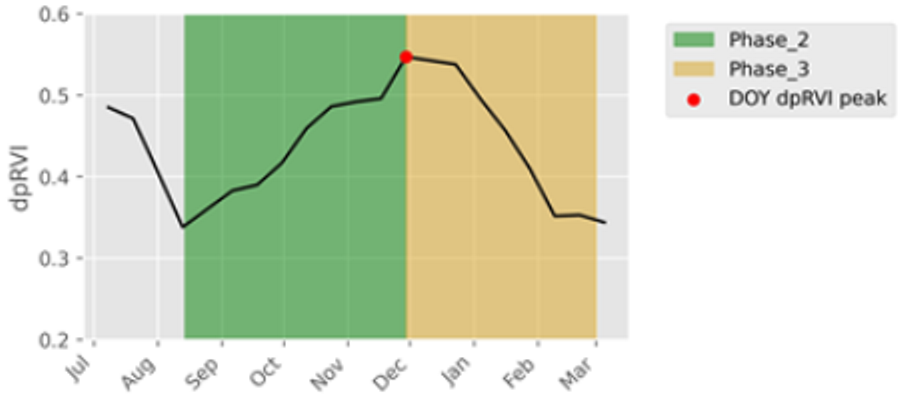 |
| dpRVI_Peak | The dpRVI value on the day of peak. The peak value is expected to change with type of catch crop and high/low biomass. | 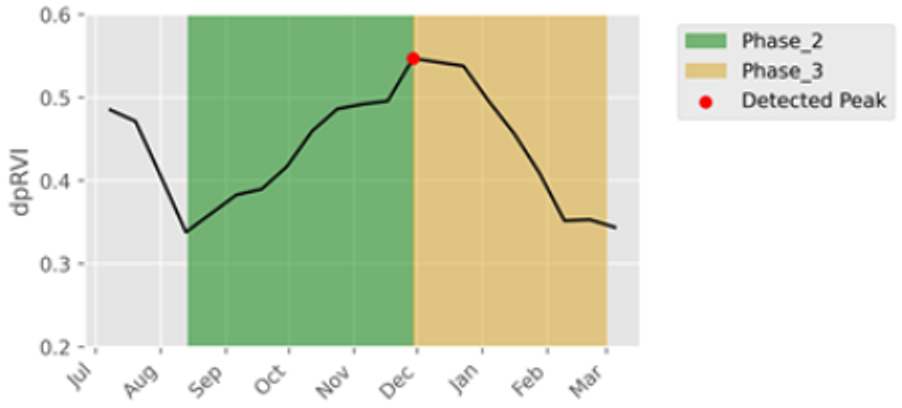 |
| Start_of_Season (SOS) | The day when dpRVI first reaches the 10% increase in seasonal amplitude of dpRVI from the minimum level in Phase 2, denoting the start of the growing phase of catch crops. For cold-sensitive varieties, SOS is expected to be early than other varieties due to their early sowing. |  |
| End_of_Season (EOS) | The day when dpRVI first reaches 10% decrease in seasonal amplitude of dpRVI from the minimum level in Phase 3, indicating the end of the growing season of catch crops. For cold-sensitive varieties, EOS is expected to be early than other varieties due to their early die-off nature. |  |
| Start_of_senescence | The day when dpRVI first reaches 90% of the seasonal amplitude from the minimum level in Phase 3, indicating the onset of senescence of catch crops. The DOY of senescence varies according to the early harvest or die-off nature and frozen events of the catch crop classes. |  |
| DOY_min_Phs1 | The day when the first local minima of dpRVI is reached in Phase 1. This indicates the harvest of main crops (winter wheat or winter barley). Harvest dates are expected to be early for cold-sensitive ones and late for cold-tolerant varieties. |  |
| Number_of_levelshift | The number of level-shift points, indicating the abrupt changes in the time series of dpRVI and calculated by taking into account of entire time period of Phase 1 and Phase 2. With harvest, plowing, mowing, frost, and precipitation events, the number of level shifts tends to increase. |  |
| DpRVI_var_Phs2 | This denotes the steadiness of vegetation activity temporally and is calculated by taking mean variance in Phase 2. The observed variance increases with management activities such as plowing, harvest and so on. |  |
| VV_Mean_Phs2, VH_Mean_Phs2, VH/VV_Mean_Phs2, dpRVI_Mean_Phs2 | This denotes the active vegetation cover of catch crop parcel and is computed by taking the mean of given parameter (VV, VH, VH/VV backscatter and dpRVI) in Phase 2 and high value indicates the successful catch crop cultivation. | 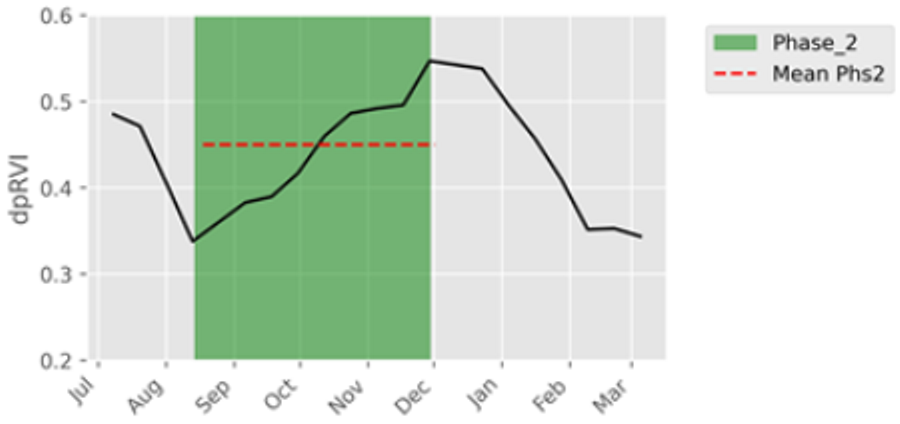 |
| VV_Sum_Phs2, VH_Sum_Phs2, VH/VV_Sum_Phs2, dpRVI_Sum_Phs2 | This denotes the cumulative sum of given parameter (VV, VH, VH/VV backscatter and dpRVI) in Phase 2 and the values vary according to strength of vegetative cover of the catch crop field. | 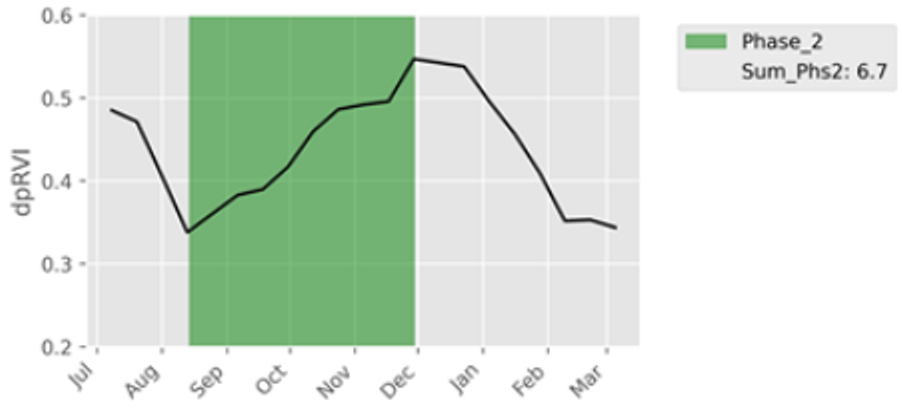 |
| VV_Mean_Phs3, VH_Mean_Phs3, VH/VV_Mean_Phs3 | Computed by taking the mean of given parameter such as VV, VH, and VH/VV backscatter in Phase 3. The relatively observed low values (compared to Phase 1) correspond to loss of chlorophyll and vegetation water content (decrease in strength of vegetation activity) as the catch crop progresses towards ripening and harvest (note that dpRVI is excluded due to no significant difference). |  |
| VV_Sum_Phs3, VH_Sum_Phs3, VH/VV_Sum_Phs3 | Cumulative sum of VV, VH, VH/VV backscatter, respectively, of the given parcel in Phase 3. The relatively observed low sum values compared to Phase 1 indicate a decrease in the strength of vegetation as the crop enters the ripening and harvest phase (note dpRVI is excluded due to no significant difference). |  |
| No. | Predictors | Kruskal Wallis Test | |
|---|---|---|---|
| H-Statistic | p-Value | ||
| 1 | dpRVI_Peak | 64.791 | 0.000 *** |
| 2 | dpRVI_DOY_Peak | 21.494 | 0.000 *** |
| 3 | dpRVI_mean_Phs2 | 11.039 | 0.003 ** |
| 4 | dpRVI_var_Phs2 | 20.776 | 0.000 *** |
| 5 | No_of_levelshift | 20.127 | 0.000 *** |
| 6 | dpRVI_sum_Phs2 | 41.788 | 0.000 *** |
| 7 | SOS | 74.362 | 0.000 *** |
| 8 | EOS | 1.216 | 0.544 |
| 9 | Start_of_senescence | 42.772 | 0.000 *** |
| 10 | DOY_min_Phs1 | 61.822 | 0.000 *** |
| 11 | VV_mean_Phs2 | 67.83 | 0.000 *** |
| 12 | VV_mean_Phs3 | 31.456 | 0.000 *** |
| 13 | VV_sum_Phs2 | 73.105 | 0.000 *** |
| 14 | VV_sum_Phs3 | 71.202 | 0.000 *** |
| 15 | VH_mean_Phs2 | 64.212 | 0.000 *** |
| 16 | VH_mean_Phs3 | 61.967 | 0.000 *** |
| 17 | VH_sum_Phs2 | 86.495 | 0.000 *** |
| 18 | VH_sum_Phs3 | 79.392 | 0.000 *** |
| 19 | VH/VV_mean_Phs2 | 28.404 | 0.000 *** |
| 20 | VH/VV_mean_Phs3 | 50.086 | 0.000 *** |
| 21 | VH/VV_sum_Phs2 | 44.879 | 0.000 *** |
| 22 | VH/VV_sum_Phs3 | 56.718 | 0.000 *** |
| Predictors | CT/CS | CS/L | L/CT |
|---|---|---|---|
| dpRVI_Peak | 1.35 *** | 3.90 *** | 1.71 |
| dpRVI_DOY_Peak | 2.57 | 2.60 *** | 2.17 ** |
| dpRVI_mean_Phs2 | 1.27 * | 5.59 ** | 1.000 |
| dpRVI_var_Phs2 | 6.04 | 1.96 | 1.43 * |
| No_of_levelshift | 8.00 *** | 5.29 | 9.84 *** |
| dpRVI_sum_Phs2 | 5.11 *** | 1.08 ** | 6.58 |
| SOS | 3.29 *** | 3.34 *** | 1.66 ** |
| Start_of_senescence | 2.02 * | 7.84 ** | 1.96 *** |
| DOY_min_Phs1 | 9.06 *** | 1.34 ** | 1.48 * |
| VV_mean_Phs2 | 3.00 *** | 3.54 *** | 1.60 *** |
| VV_mean_Phs3 | 2.84 * | 3.54 *** | 6.96 *** |
| VV_sum_Phs2 | 1.80 *** | 9.77 *** | 1.67 *** |
| VV_sum_Phs3 | 3.97 * | 1.91 *** | 1.49 *** |
| VH_mean_Phs2 | 1.51 *** | 1.00 | 9.08 |
| VH_mean_Phs3 | 8.53 *** | 1.34 *** | 1.18 |
| VH_sum_Phs2 | 4.12 *** | 1.36 *** | 2.34 *** |
| VH_sum_Phs3 | 2.98 *** | 1.18 *** | 1.67 *** |
| VH/VV_mean_Phs2 | 7.07 | 4.74 *** | 4.17 ** |
| VH/VV_mean_Phs3 | 4.53 *** | 2.09 *** | 2.17 ** |
| VH/VV_sum_Phs2 | 4.00 *** | 4.70 *** | 1.000 |
| VH/VV_sum_Phs3 | 1.47 *** | 2.70 *** | 1.000 |
Disclaimer/Publisher’s Note: The statements, opinions and data contained in all publications are solely those of the individual author(s) and contributor(s) and not of MDPI and/or the editor(s). MDPI and/or the editor(s) disclaim responsibility for any injury to people or property resulting from any ideas, methods, instructions or products referred to in the content. |
© 2024 by the authors. Licensee MDPI, Basel, Switzerland. This article is an open access article distributed under the terms and conditions of the Creative Commons Attribution (CC BY) license (https://creativecommons.org/licenses/by/4.0/).
Share and Cite
Selvaraj, S.; Bargiel, D.; Htitiou, A.; Gerighausen, H. Analyzing Temporal Characteristics of Winter Catch Crops Using Sentinel-1 Time Series. Remote Sens. 2024, 16, 3737. https://doi.org/10.3390/rs16193737
Selvaraj S, Bargiel D, Htitiou A, Gerighausen H. Analyzing Temporal Characteristics of Winter Catch Crops Using Sentinel-1 Time Series. Remote Sensing. 2024; 16(19):3737. https://doi.org/10.3390/rs16193737
Chicago/Turabian StyleSelvaraj, Shanmugapriya, Damian Bargiel, Abdelaziz Htitiou, and Heike Gerighausen. 2024. "Analyzing Temporal Characteristics of Winter Catch Crops Using Sentinel-1 Time Series" Remote Sensing 16, no. 19: 3737. https://doi.org/10.3390/rs16193737





